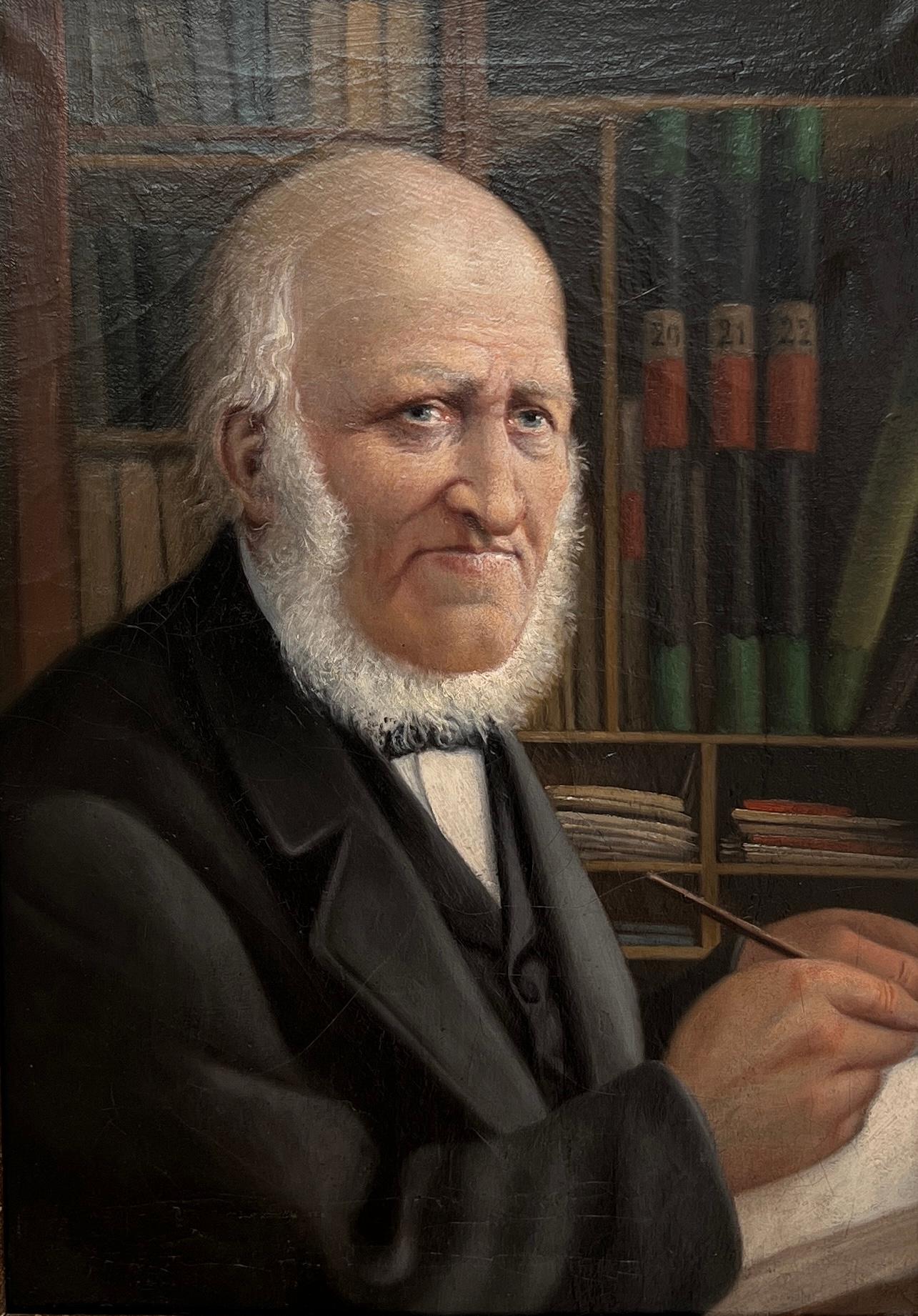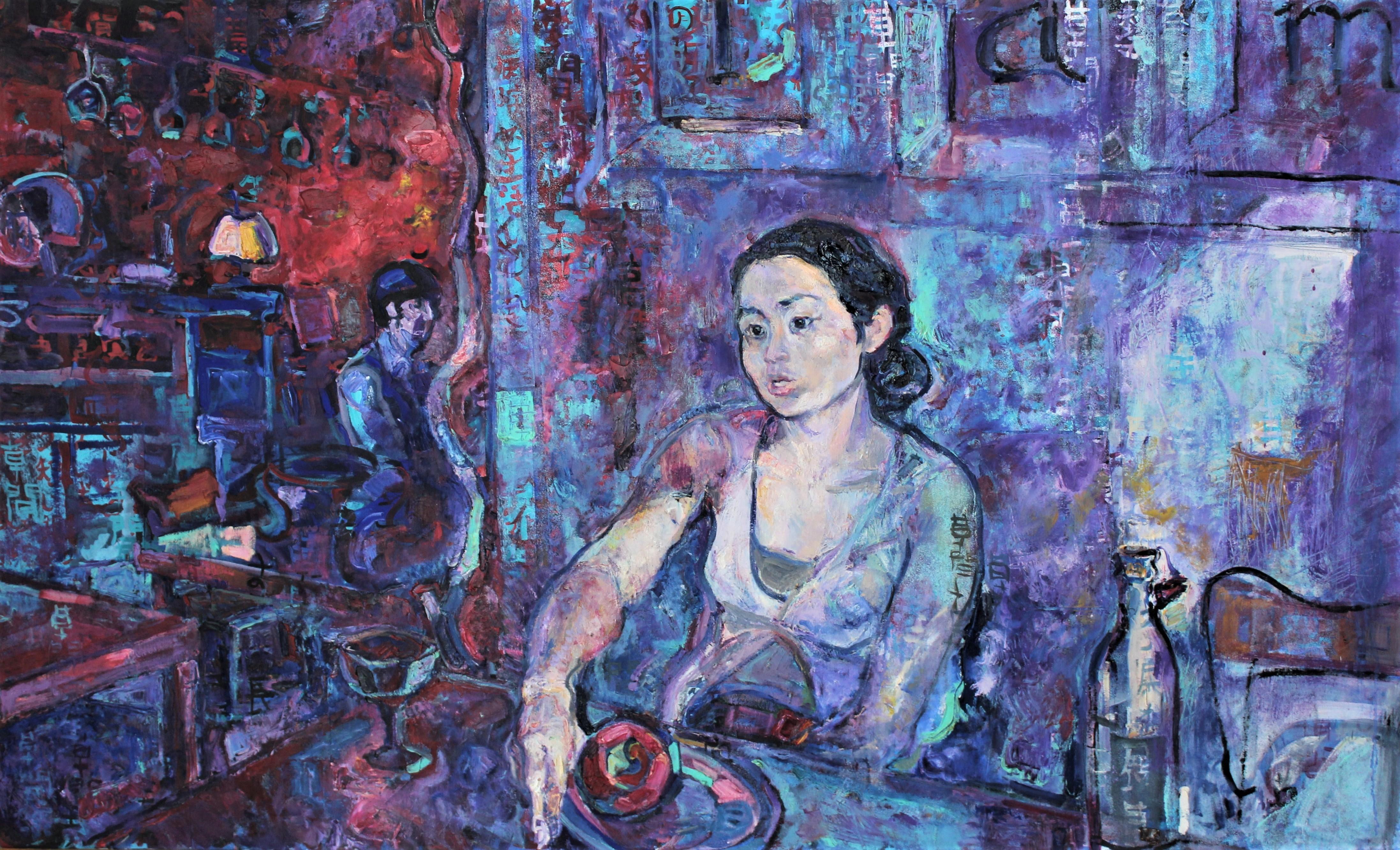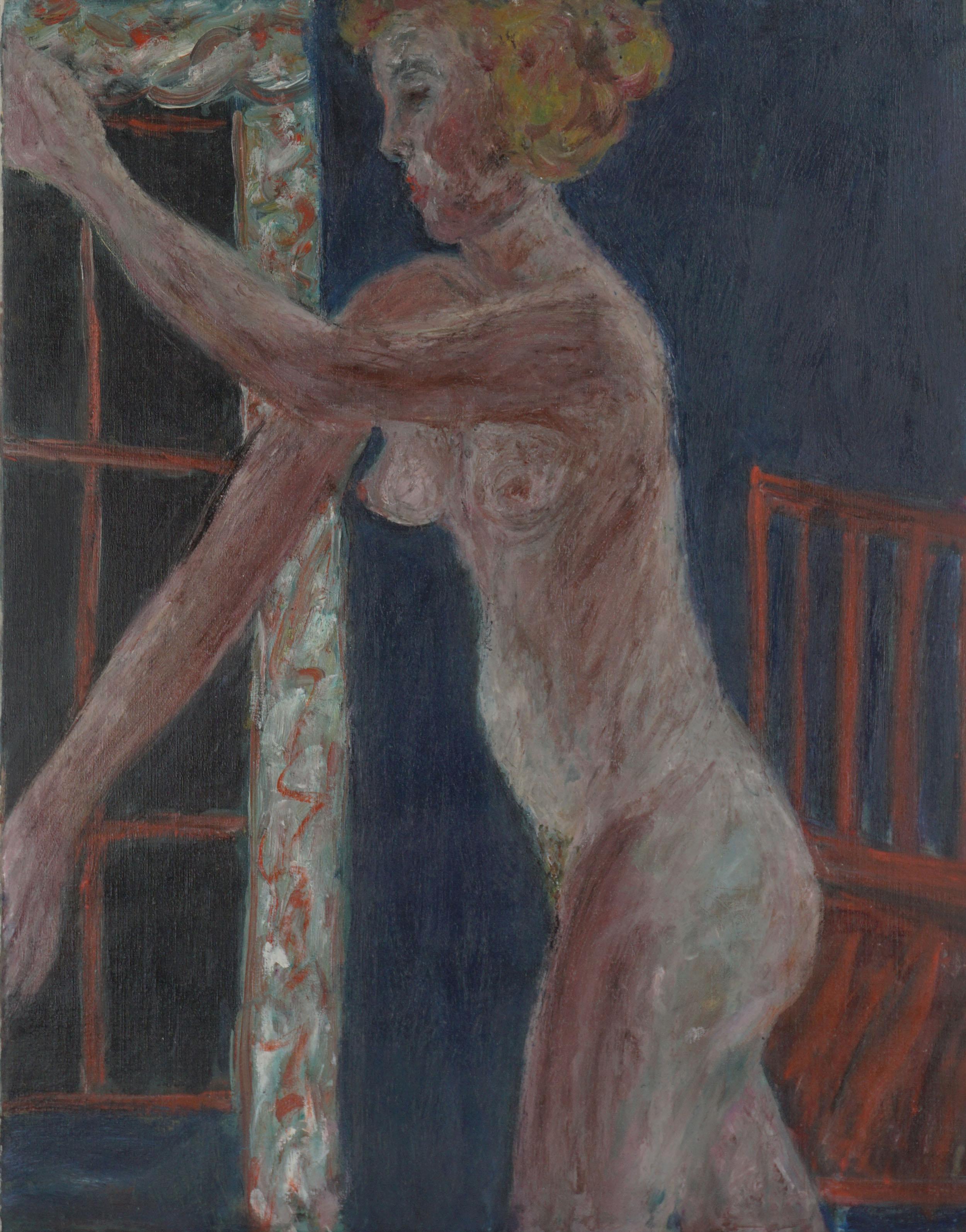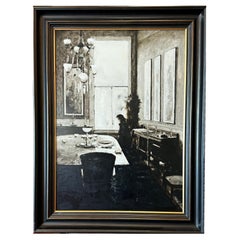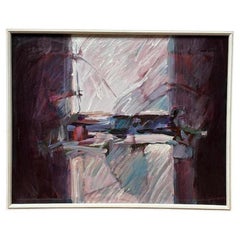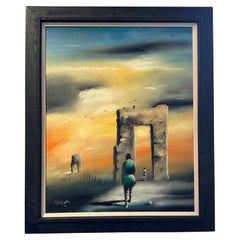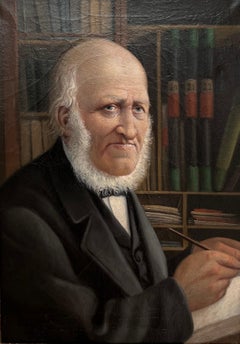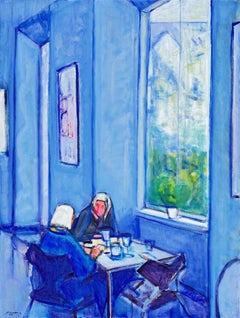Items Similar to Daily Life Scene in a 17th Century Vermeer Style - Dutch Oil Painting on Canvas
Want more images or videos?
Request additional images or videos from the seller
1 of 9
UnknownDaily Life Scene in a 17th Century Vermeer Style - Dutch Oil Painting on Canvas1948
1948
About the Item
This tribute painting to Flemish art by an unknown artist portrays figures inside a mansion with a yellow and black checkerboard floor and a stained-glass window with brilliant colors as a backdrop. It definitely reminds the viewers of Vermeer's universe.
The three characters include two knights holding a drink and a woman, likely the wife of one of them. In this painting, the use of a meticulous technique to render human figures and apparel provides the setting for depicting a domestic bourgeois event. But the artwork goes beyond simply presenting a scene from daily life. What sets this painting apart is its use of light and shadow to capture every intricate detail. The characteristic play of velvety textures and light reflects the region's specific weather. The diffuse light coming from the overcast sky, shining through the right window, lends the room a subtly subdued ambiance. It definitely reminds us of the quality of the light found in the Flanders or even in the Picardy or Artois regions.
Flemish art is internationally renowned for its vivid depictions of narrative scenes and unsurpassed technical skills. It often features heroes and chivalric themes, with athletic men and radiant women, portrayed as fresh and spontaneous, yet lacking in grace and distinction. Vibrant, flowing fabrics serve as a framework to activate the striking effect of oil pigments on clothes.
This painting sits in a beautiful custom-made frame. It is signed and dated (1948) by the artist on a parchment paper half dangling from the table, near a vase on which the painter wrote a Dutch saying: "Melck is goed voor Elck" which can be translated by "Milk is good for everyman".
- Creation Year:1948
- Dimensions:Height: 38.5 in (97.79 cm)Width: 64 in (162.56 cm)Depth: 3 in (7.62 cm)
- Medium:
- Movement & Style:
- Period:
- Condition:The paint has tiny cracks, like many of these old paintings, which is typical of the patina of this type of artwork.
- Gallery Location:Pasadena, CA
- Reference Number:1stDibs: LU654312274602
About the Seller
5.0
Vetted Professional Seller
Every seller passes strict standards for authenticity and reliability
Established in 1999
1stDibs seller since 2017
71 sales on 1stDibs
Typical response time: 14 hours
- ShippingRetrieving quote...Shipping from: Pasadena, CA
- Return Policy
Authenticity Guarantee
In the unlikely event there’s an issue with an item’s authenticity, contact us within 1 year for a full refund. DetailsMoney-Back Guarantee
If your item is not as described, is damaged in transit, or does not arrive, contact us within 7 days for a full refund. Details24-Hour Cancellation
You have a 24-hour grace period in which to reconsider your purchase, with no questions asked.Vetted Professional Sellers
Our world-class sellers must adhere to strict standards for service and quality, maintaining the integrity of our listings.Price-Match Guarantee
If you find that a seller listed the same item for a lower price elsewhere, we’ll match it.Trusted Global Delivery
Our best-in-class carrier network provides specialized shipping options worldwide, including custom delivery.More From This Seller
View AllContemporary Acrylic Abstract Painting by Mitchell Wright
Located in Pasadena, CA
This blue monochrome painting by contemporary artist Mitchel Wright transports us to distant worlds beyond our comprehension. Within his seemingly infinite networks of lines, dots, and crosses, he decodes the recognizable to create something unfamiliar.
Wright crosses shades of blue and grey lines, reconstructing a sense of regularity obtained by the arrangement of different triangles sizes. The triangular forms used for the painting contrast with the perfect square shape of the artwork. It sits in a grey metal frame.
Mitchell Wright...
Category
Late 20th Century Contemporary Abstract Paintings
Materials
Canvas, Acrylic
"Dining Room " Monochromatic Interior Scene in Sepia Tones by Geoffrey Johnson
By Geoffrey Johnson
Located in Pasadena, CA
Sepia tones permeate this remarkable oil painting by American artist Geoffrey Johnson, who captures a hauntingly timeless scene. A woman waits by the window of her home, silent, almost absorbed in the diffuse ambiance of the room?
The artist emphasizes the intimacy of his subject, a silhouette between presence and absence whose identity he has limited to a shadow. The woman is treated like a ghost, associating her with the invisible and the forgotten.
In all its diversity, art is a step towards understanding human emotions and, often, an opening into the soul. The canvas analyzed here is that of a seemingly banal dining room, including an old-style kitchen area, inhabited by this quasi-incorporeal female figure. This eloquent artistic choice echos a reflection on the condition of loneliness. Few details appear some paintings on the wall, a dining table with two visible plates, a chandelier, etc.
The sepia tint is emblematic of nostalgia, reminiscent of the photographic process that ages pictures to give them an air of yesteryear. Here, the artist recalls the past, not to idolize it, but to question the persistence of female alienation over time. The deliberate use of a restricted, even desaturated chromatic range reflects a timeless universe in which the female figure echoes across the ages. Like an entity in a sepia photograph, where the being is frozen for eternity, the woman appears and disappears simultaneously, symbolizing the volatility of existence and the fragility of memory.
Johnson confronts us with a profound reflection on our solitude and relationship with time, painting the isolation of women in the hues of a bygone era. Through a technique that magnifies the essential and erases the extra, he resurrects an atmosphere inviting us to reinterpret our reflection on existence.
--------------------------------------------------------------------
Born in 1965 in Greensboro, North Carolina, Geoffrey Johnson graduated from the Pennsylvania Academy of Fine Arts, where he received several awards and prizes for his artistic excellence. Since 1995, he has exhibited in galleries and venues throughout the United States. His paintings may be found in many private and corporate collections, including those of Coca-Cola, Turner Broadcasting, BellSouth, and Wells Fargo.
Johnson draws much of his inspiration from his travel experiences and first-hand observations. Using a monochromatic palette of sepia hues, the artist strives to reproduce the places that inspire him. Johnson’s work is powerfully evocative of the French Impressionists’ depictions of city life, interior spaces, and equestrian scenes. From Gustave Caillebotte’s steely, atmospheric renderings of foggy Paris streets and dusky rooftops to Degas’ spindly-legged racehorses, the influence of these artists upon Johnson’s painting is readily visible. His manner of distorting the human figure has also been likened to the skeletal, surreal forms of Alberto Giacometti.
Johnson has established himself as a true innovator, successfully capturing the alluring space between abstraction and realism. His work is significantly influenced by his fascination with both the human figure and the powerful architecture of a modern city. Through a feeling of anonymity, figures become suggestive shapes, and the skyline of New York materializes mysteriously in the background. Johnson’s paintings embody the mood of each urban experience.
Johnson has “always been attracted to interiors, work spaces [and] personal spaces.” Inspired by a box of...
Category
21st Century and Contemporary Interior Paintings
Materials
Oil
"My Two Windows" Oil Painting on Canvas by Wesley Johnson
By Wesley Johnson
Located in Pasadena, CA
In this composition, Californian artist Wesley Johnson invites us to contemplative stillness. The abstract essence of this work flourishes into a living entity, enriched by a blend o...
Category
Mid-20th Century Abstract Expressionist Abstract Paintings
Materials
Oil
"Hope : Between Earth and Heaven" Surrealist Acrylic on Canvas by Eugene Hawkins
Located in Pasadena, CA
In the "Fantasy/Metaphysical" series by American artist Eugene Hawkins, the convergence of surrealism and metaphysics unfolds as an exploration of existential themes common to all. C...
Category
1960s Surrealist Figurative Paintings
Materials
Canvas, Oil
"La Belle Raphaela" Oil on Canvas after Tamara de Lempicka
By (after) Tamara de Lempicka
Located in Pasadena, CA
This tribute art piece - an awe-inspiring representation of a nude, lascivious woman before or after an intimate embrace - is a celebration not only of Tamara de Lempika’s skill and ...
Category
1980s Nude Paintings
Materials
Canvas, Oil
$1,760 Sale Price
20% Off
Still-Life Blue Tones Oil on Canvas by Edward Sotello
Located in Pasadena, CA
With this oil painting realized by the Californian artist Edward Sotello, we can clearly see on the right a glass, a vase, and some flowers placed on a table. On the left, a possible...
Category
Mid-20th Century Expressionist Still-life Paintings
Materials
Canvas, Oil
$680 Sale Price
28% Off
You May Also Like
Floral Still Life Country Flowers in a Vase by Flemish Barbizon artist in France
Located in Norwich, GB
A gorgeous floral still life which marries the depth and the richness found in the work of the Flemish old masters with the elegance and light of French painting. As you will see, th...
Category
1880s Flemish School Interior Paintings
Materials
Oil, Panel
The Librarian
Located in Genève, GE
Work on canvas : 61 x 43 cm
Golden frame
With frame : 70 x 52.7 x 4 cm
This 19th-century portrait by an anonymous artist shows an elderly man seated at his desk, engrossed in writing...
Category
19th Century Academic Interior Paintings
Materials
Oil, Canvas
$2,160
The Conversation II
Located in Greenwich, CT
Signed lower left
Elizabeth Higgins (Canadian, b. 1960)
Elizabeth Higgins describes herself as an abstract figurative and landscape painter. Everything around her serves as a potential subject, an inspiration to begin a painting. Fidelity to the landscape, the figure, or the still life is relative, as she isn’t interested in literal depictions; instead, it’s the abstract relationships of these shapes and colors, the abstract pictorial design that drives her work.
Higgins’ paintings are rooted in the tradition stemming from Courbet, Derain, Bonnard, Matisse, Morandi, German Expressionism, and the Canadian Group of Seven (also known as the Algonquin School of landscape painters, 1920–1933). She is influenced by the work of her artist-teachers Paul Resika—himself a student of Hans Hofmann—and Robert De Niro, Sr. (1922-1993), as well as the paintings of contemporary artist Peter Doig. Her artistic evolution stretches across this continuum.
It is the “in-between”, the hovering between representation and abstraction, that interests her, not the labeling effect of details; instead, she aims directly at the spirit of the painting—of making something come to life. John Goodrich wrote in her catalog essay, “Elizabeth Higgins’ direct brushwork and simplified forms suggest an energy, but crucially, reveal a painter who knows the power of color…”
Elizabeth Higgins was born in Toronto, Canada, in 1960. As a Helena...
Category
2010s Contemporary Figurative Paintings
Materials
Canvas, Oil
"The Artist's Wife at the Loom, " Harry Hoffman, Bright American Impressionism
By Harry Leslie Hoffman
Located in New York, NY
Harry Leslie Hoffman (1871 - 1964)
The Artist's Wife (Beatrice Pope) at the Loom, circa 1915
Oil on canvas
30 x 32 inches
Housed in a period Newcomb-Macklin frame
Provenance:
Estate of the artist
Private Collection, Massachusetts
This painting depicts the artist's wife at the loom, producing textile versions of Hoffman's underwater paintings. The screen shown behind Bea is an underwater scene also painted by Hoffman. The study of this painting is held in the collection of the Wolfsonian Museum in Florida.
Harry Leslie Hoffman was born in Cressona, a small community in Pennsylvania's Schuylkill Valley. His mother was an amateur artist who encouraged her son to pursue a career in the arts. In 1893, Hoffman entered the School of Art at Yale University and studied with John Ferguson Weir, the son of Robert Walter Weir. After graduation in 1897, Hoffman moved to New York to continue his studies at the Art Students League. He also traveled to Paris and took classes at the Académie Julien.
In the summer of 1902, Hoffman attended the Lyme Summer School of Art, in the town of Old Lyme on the Connecticut coast. The school was headed by Frank Vincent Dumond and was located in a boarding house owned by Florence Griswold. The school eventually grew into an artists' colony and a center for American Impressionism. When Hoffman first arrived as a student, he was not permitted to stay in the house which was designated for the professional artists only. However, his outgoing personality soon won him many friends at the colony.
In 1905, Hoffman settled in Old Lyme and worked as a full member of the artist colony. He was particularly influenced by Willard Leroy Metcalf, an Impressionist also working in Old Lyme. Fellow artists later fondly recalled Hoffman's antics at the Griswold house, which included playing the flute and banjo, tap-dancing, singing humorous songs, and performing magic tricks. In 1910 Hoffman...
Category
1910s American Impressionist Figurative Paintings
Materials
Canvas, Oil
E in Red Caffe - Oil Painting Red Blue Yellow White Green
By Elena Georgieva
Located in Sofia, BG
"E in Red Caffe " is an impressionist painting by Maestro Elena Georgieva.
The painting is unframed.
About the artwork:
TECHNIQUE: Oil painting
STY...
Category
2010s Impressionist Figurative Paintings
Materials
Canvas, Oil
Mid Century Abstract Expressionist Figurative -- Nude Woman and Red Chair
By Honora Berg
Located in Soquel, CA
Wonderful mid century abstract figurative nude at night with red chair by Honora Berg (American, 1897-1985). A nocturnal setting adds more interest and dimension. Signed on verso "H Berg." Unframed. 36"H x 30"W.
Honora Berg an early Bay Area Figurative and Abstract Expressionist painter. She studied at the San Francisco Art Institute with David Park, Elmer Bischoff, and James Budd Dixon. Berg's friend Edith Truesdell...
Category
1960s American Modern Figurative Paintings
Materials
Oil, Canvas
$2,280 Sale Price
20% Off
Recently Viewed
View AllMore Ways To Browse
Mansion Painting
Vintage Dutch Scenes
Dutch Woman Oil
Flemish Table
Stained Glass Window Three
17th Century Flemish School
17th Century Dutch Table
Vintage Woman Drinking
Yellow Milk Glass
Drinking Set Glass Painted
Flanders Oil Painting
Stained Glass Dutch
17th Century Flemish Table
Knight Vase
Vintage Yellow Drinking Glasses
Painted Vintage Milk Cans
Ferrari Car Art
Fortuny Paintings
